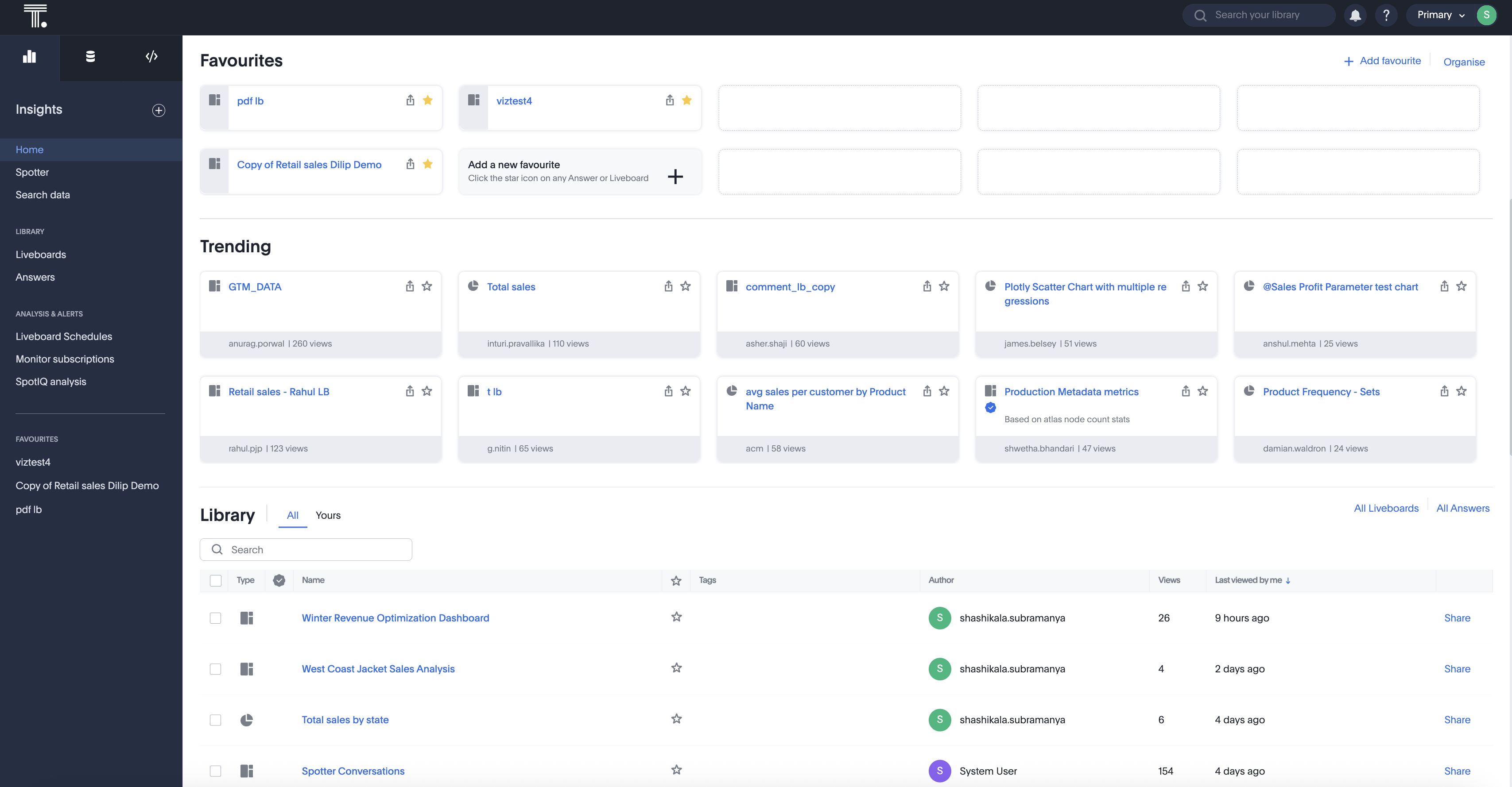
Customize full application embed
- UI and navigation experience
- Choose the default page to load
- Customize Search experience in full app embed
- Customize navigation controls
- Customize Home page modules (New experience)
- Hide columns on list pages
- Detect changes in the currently loaded page
- Navigate using a custom action
- CSS customization and hiding page elements
- Additional resources
UI and navigation experience🔗
In full application embedding, the ThoughtSpot UI and navigation are available in the following modes:
-
Classic experience (default)
-
New modular home page with sliding navigation panel Early Access
-
New modular home page and navigation without the sliding panel Early Access
New modular home page with a sliding navigation panel🔗
The new navigation and modular home page experience provides an intuitive and efficient navigation structure. It organizes the application menu into persona-based modules designed specifically to address users' needs. Each module has a menu selector with a visual icon, to allow users to switch between contexts easily. Users can slide out the left navigation panel by clicking the hamburger icon in the header.
If your application instance has classic experience, you’ll notice the following changes when the new experience is enabled:
-
A redesigned UI with a sliding navigation panel.
-
The app selector icons for Insights, Data workspace, and Develop appear in the header section of the left navigation panel. This selector provides access to persona-based apps, replacing the old top navigation menu. The left navigation panel provides quick access to different modules and can be customized.
-
The Admin module is available under the user settings section in the top right corner.
-
The Home page is available in the Insights section. The Home page is customizable and includes features such as Natural Language Search, watchlist, favorites, a library of Answers and Liveboards, and trending charts.
-
The Insights section in the left navigation panel provides quick access to the Home page, Answers, Liveboards, and more. The panel also includes a list of users' favorites.
-
The top navigation panel includes the following components:
-
A Hamburger icon to allow users to slide out or slide in the navigation panel.
-
Object search bar with quick access to the library.
-
An Alert icon that shows notifications
-
Help icon to access documentation
-
Org switcher to switch between Org contexts
-
Access to Profile, Admin settings (if the user has administrator privilege), and Sign out options.
-
The following figure shows the new navigation panel and modular Home page:

Modular Home page🔗
The customizable home page in ThoughtSpot’s new experience is available in the Insights section. It allows users to personalize the layout and content modules. Users can reorder sections, such as watchlist, favorites, library, trending charts, and more. For full app embedding application users, developers can set a default layout to include only the modules they want.
Configure new experience🔗
The navigation and home page experience is turned off by default. Administrators can enable it on their instance at the cluster level for all users. When this feature is enabled on the instance, users can switch between classic and new experience by turning off or enabling the experience in their profile settings. On embedded applications, you’ll need to enable this experience using the discoveryExperience property as shown in this example:
const embed = new AppEmbed('#tsEmbed', {
// Enable the new modular home page and navigation experience
modularHomeExperience: true,
// Set the top navigation bar in the embedded view
showPrimaryNavbar: true,
discoveryExperience: {
// Set the navigation bar to use the new sliding (icon-based) style
primaryNavbarVersion: PrimaryNavbarVersion.Sliding,
// Set the home page to use the modular layout
homePage: 'Modular',
},
//other options
});New navigation and Home page experience without the sliding panel🔗
In the new navigation and Home page experience, the app selector  appears on the top header bar. The app selector consists of different persona-based contextual elements to allow users to switch between contexts. Clicking an app in the app selector menu opens the corresponding application page. Each application module has a separate left navigation panel.
appears on the top header bar. The app selector consists of different persona-based contextual elements to allow users to switch between contexts. Clicking an app in the app selector menu opens the corresponding application page. Each application module has a separate left navigation panel.
If your application instance has classic experience, you’ll notice the following changes in the UI:
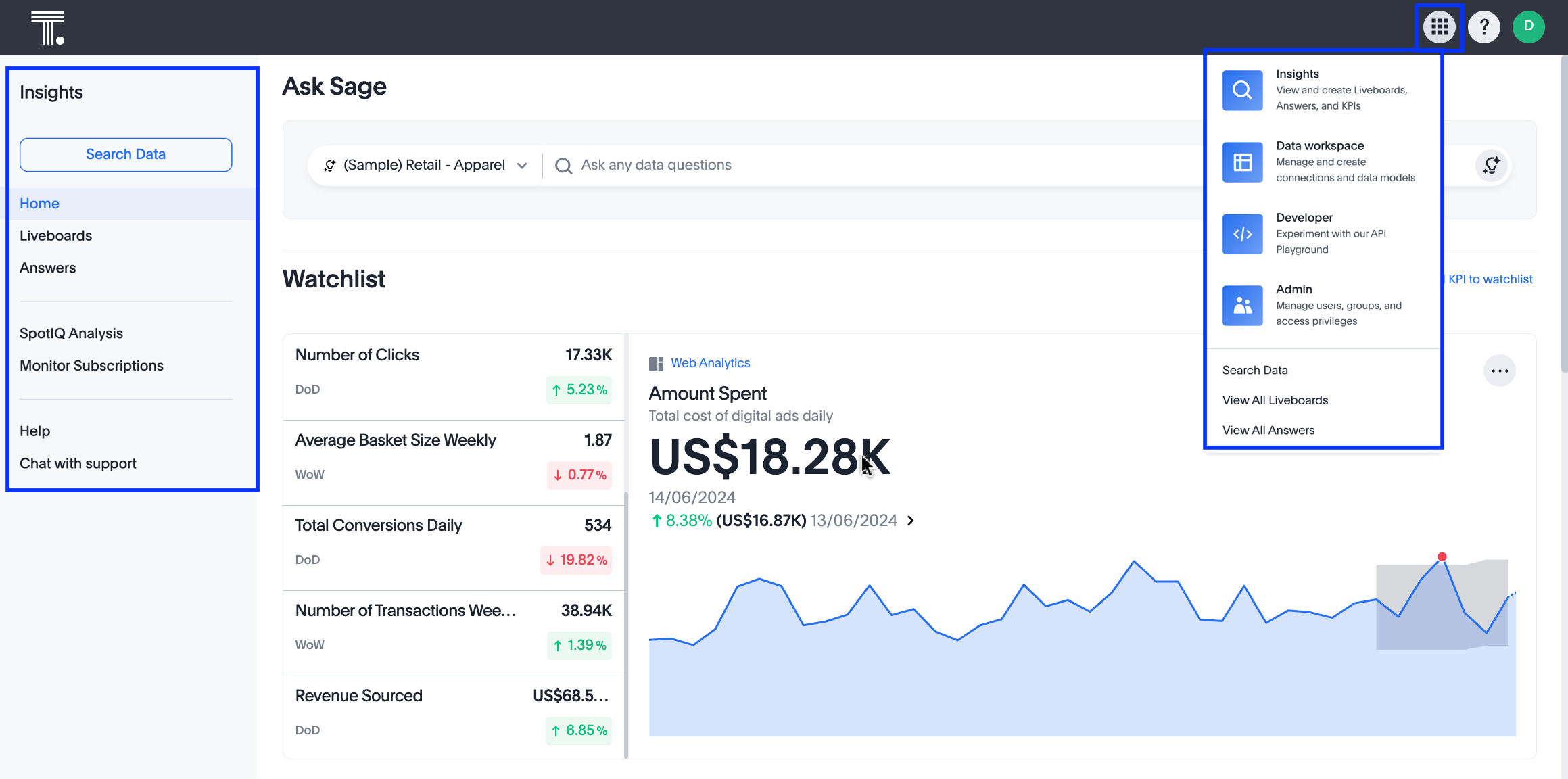
The new navigation and Home page experience introduces several UI changes.
View UI changes
| Classic experience | New navigation and Home page experience | |
|---|---|---|
Navigation | Top navigation menu with the following buttons:
| App selector
|
Home page experience | In the classic experience mode, the Home page shows the Natural Language Search panel, a list of Answers and Liveboards, and trending charts. | The Insights page in new experience mode shows a customizable home page with features such as Natural Language Search panel, watchlist, favorites, a library of Answers and Liveboards, trending charts, and more. With the new left-hand navigation, users can navigate to your Liveboards, Answers, SpotIQ analysis, and Monitor subscriptions. |
Application page URLs |
|
|
Liveboards and Answers | In the classic experience mode, users can use All, Yours, and Favorites tabs to filter the Liveboards and Answers list | In new experience, the Liveboard and Answers list page provides filters for each column. For example, to view their favorite Liveboards, users can click the star icon in the column head and apply a filter to show only their starred (favorite) Liveboards. Similarly, users can filter the list by author to view only their Liveboards or Answers. |
Enable new experience mode without the sliding panel🔗
By default, the new navigation and home page experience is turned off on ThoughtSpot embedding applications. To enable the new experience mode for embedding application users, set modularHomeExperience to true in the AppEmbed component.
const embed = new AppEmbed("#embed", {
pageId: Page.Home,
modularHomeExperience: true,
frameParams: {
height: '100%',
width: '100%'
}
});Choose the default page to load🔗
When embedding the full app, you can use either pageId or path parameter to specify the page to load when the embedded component loads. If both path and pageId properties are defined, the path definition takes precedence.
pageId🔗
The pageId parameter of the AppEmbed parameters object lets you specify the ThoughtSpot page in the Page enumeration that the AppEmbed component loads to. Valid values for this attribute are:
-
Page.Homefor the ThoughtSpot Home page -
Page.Searchfor the ThoughtSpot Search page -
Page.Answersfor the Answers page -
Page.Liveboardsfor the Liveboards page -
Page.Datafor the Data page -
Page.SpotIQfor the SpotIQ analyses page
const embed = new AppEmbed("#embed", {
pageId: Page.Liveboards,
showPrimaryNavbar: false,
frameParams: {
height: '100%',
width: '100%'
}
});path🔗
The URL path of the ThoughtSpot application page that you want your embed application users to navigate to.
const embed = new AppEmbed("#embed", {
path: 'pinboard/96a1cf0b-a159-4cc8-8af4-1a297c492ff9',
frameParams: {
height: '100%',
width: '100%'
}
});The following examples show valid strings for path:
| Page | Classic experience | New navigation and Home page experience |
|---|---|---|
Home |
|
|
Answers |
|
|
Saved Answer |
|
|
Liveboards |
|
|
Liveboard |
|
|
SpotIQ analysis list |
|
|
SpotIQ analysis page |
|
|
Data |
|
|
Model, tables, views |
|
|
Monitor |
|
|
navigateToPage()🔗
The AppEmbed object has a method called navigateToPage() that will switch the currently loaded page in the ThoughtSpot embedded application. The navigateToPage() method accepts the values that work for pageId or path parameters.
The new navigation menu should call navigateToPage for the various pages you want to provide access to:
embed.navigateToPage(Page.Answers);
// with noReload option
embed.navigateToPage(Page.Answers, true);history.back()🔗
Page changes within the AppEmbed component register as part of the embedding app’s history to the web browser.
The standard JavaScript history.back() function will cause the AppEmbed component to go to the previously loaded page up until the very first ThoughtSpot page loaded within the component.
Customize Search experience in full app embed🔗
The search components available for full application embed and the configuration settings required for these components are listed in the following table:
| Type | Description |
|---|---|
Object Search | Allows finding popular Liveboards and Answers from the recommended suggestions. On instances running 10.1.0.cl or lower, the Home page provides a combined interface with Object Search and Natural Language Search. On instances running 10.3.0.cl or later, with split search experience enabled, the Object Search will be the default search experience on the Home page. The Object Search bar also appears on the top navigation bar if the top navigation bar visibility is enabled ( |
Spotter Search | In addition to AI Search capabilities, Spotter provides a conversation interface for queries and follow-up questions. For more information, see Enable AI Search with Spotter. |
Search data | Allows searching a data source using keywords and search tokens. This experience is available if you have set the |
Natural Language Search (legacy interface) | Allows searching a data source using a natural language query string and get AI-generated Answers. On instances running 10.3.0.cl or earlier, with split search experience disabled, the Search interface on the Home page provides a combined view of Natural Language Search (legacy interface) and Object Search. However, on instances running 10.3.0.cl or later, split search is enabled by default. Due to this, the Home page will not show Natural Language Search as the default search experience. Note that the legacy Natural Language Search option is deprecated and replaced with Spotter Search. You can enable Natural Language Search with Spotter, by setting |
Home page search experience options🔗
Developers can customize the Search experience by setting the homePageSearchBarMode property in the SDK to a desired value:
-
objectSearch(default)
Displays Object Search bar on the Home page. -
aiAnswer
Displays the search bar for Natural Language Search -
none
Hides the Search bar on the Home page. Note that it only hides the Search bar on the Home page and doesn’t affect the Object Search bar visibility on the top navigation bar.
Enable AI Search🔗
To set AI Search as the default search experience on the Home page, use the settings shown in the following examples.
Enable AI Search with Spotter (Recommended)🔗
To set Spotter as the default search experience on the Home page, use the settings shown in the following examples.
New Home page experience
const embed = new AppEmbed("#embed", {
modularHomeExperience: true,
isUnifiedSearchExperienceEnabled: "false",
homePageSearchBarMode: "aiAnswer",
});- Home page search experience
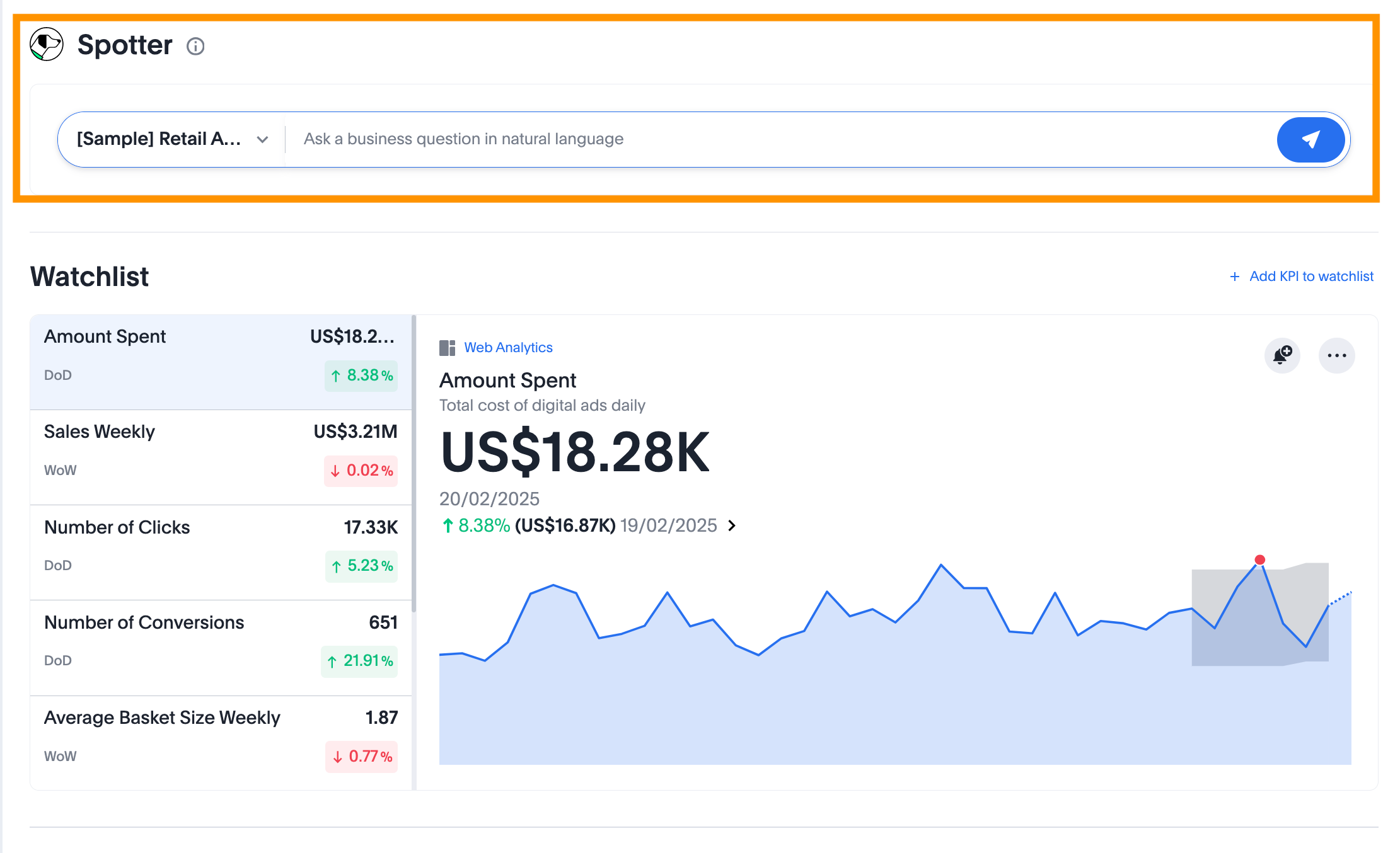
- Spotter page
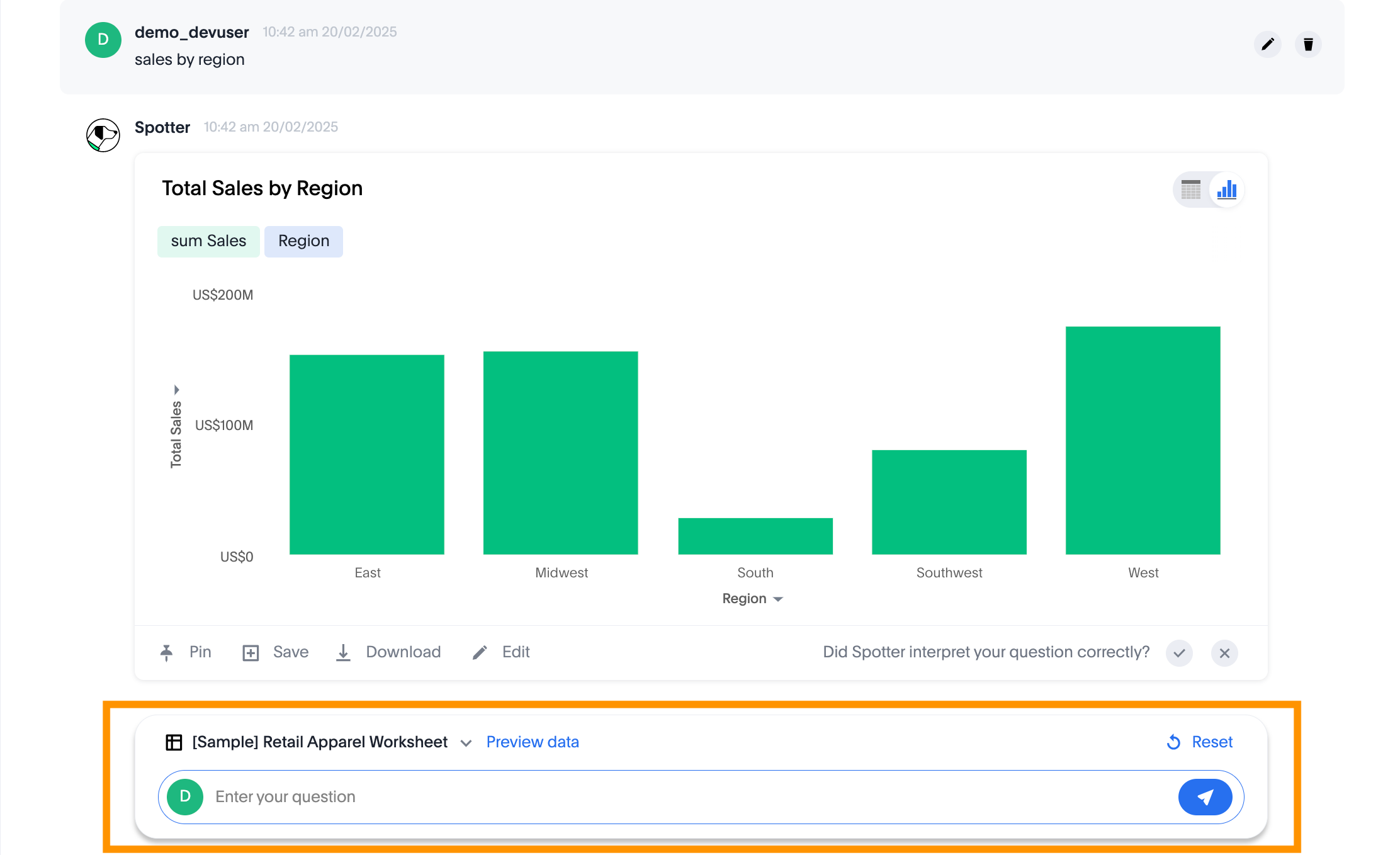
Home page classic experience
const embed = new AppEmbed("#embed", {
isUnifiedSearchExperienceEnabled: "false",
homePageSearchBarMode: "aiAnswer",
});- Home page search experience
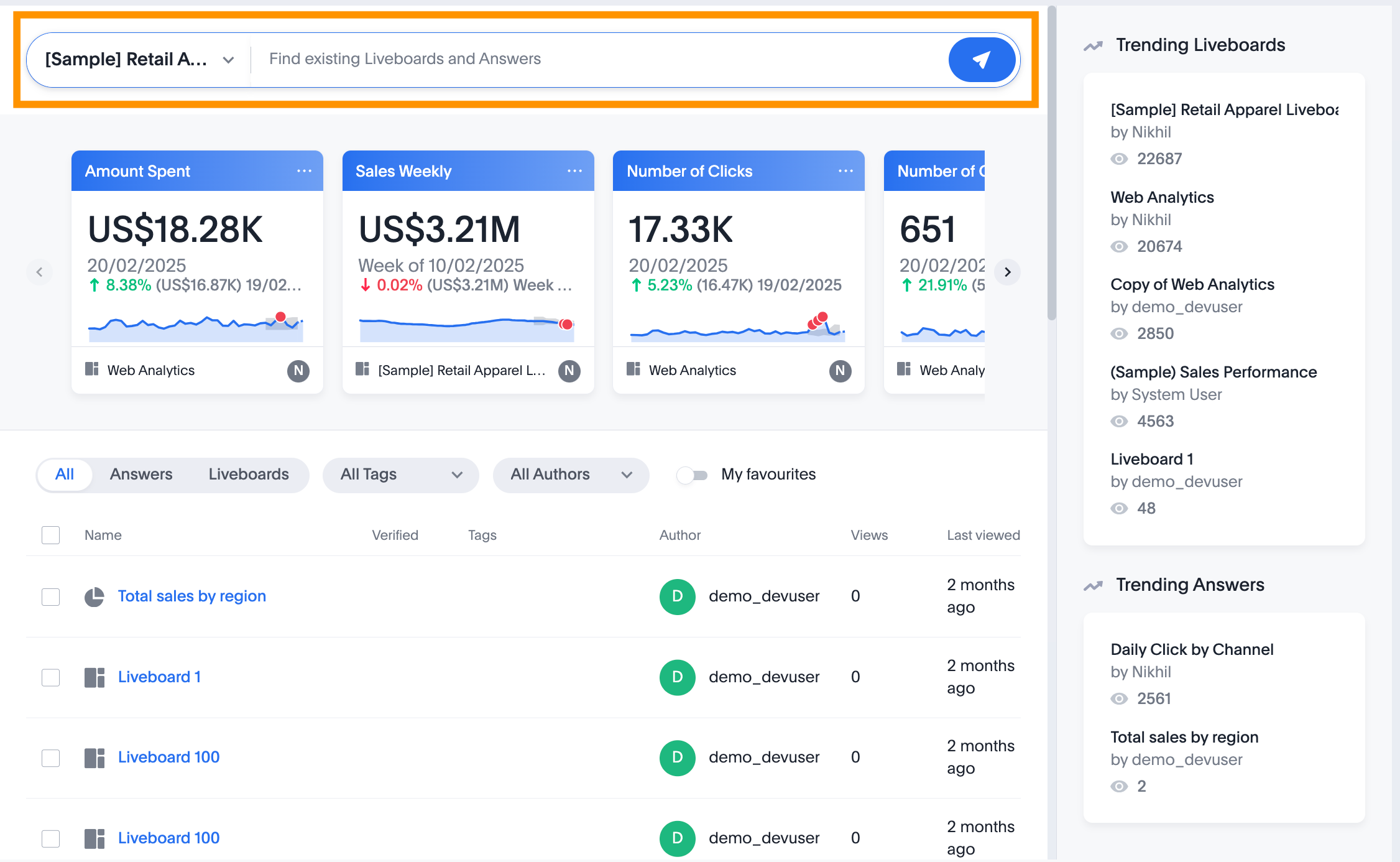
- Spotter page

Enable AI Search (legacy)🔗
To enable Natural Language Search (legacy), use the settings shown in these examples:
New Home page experience
const embed = new AppEmbed("#embed", {
modularHomeExperience: true,
homePageSearchBarMode: "aiAnswer",
});- Home page search experience
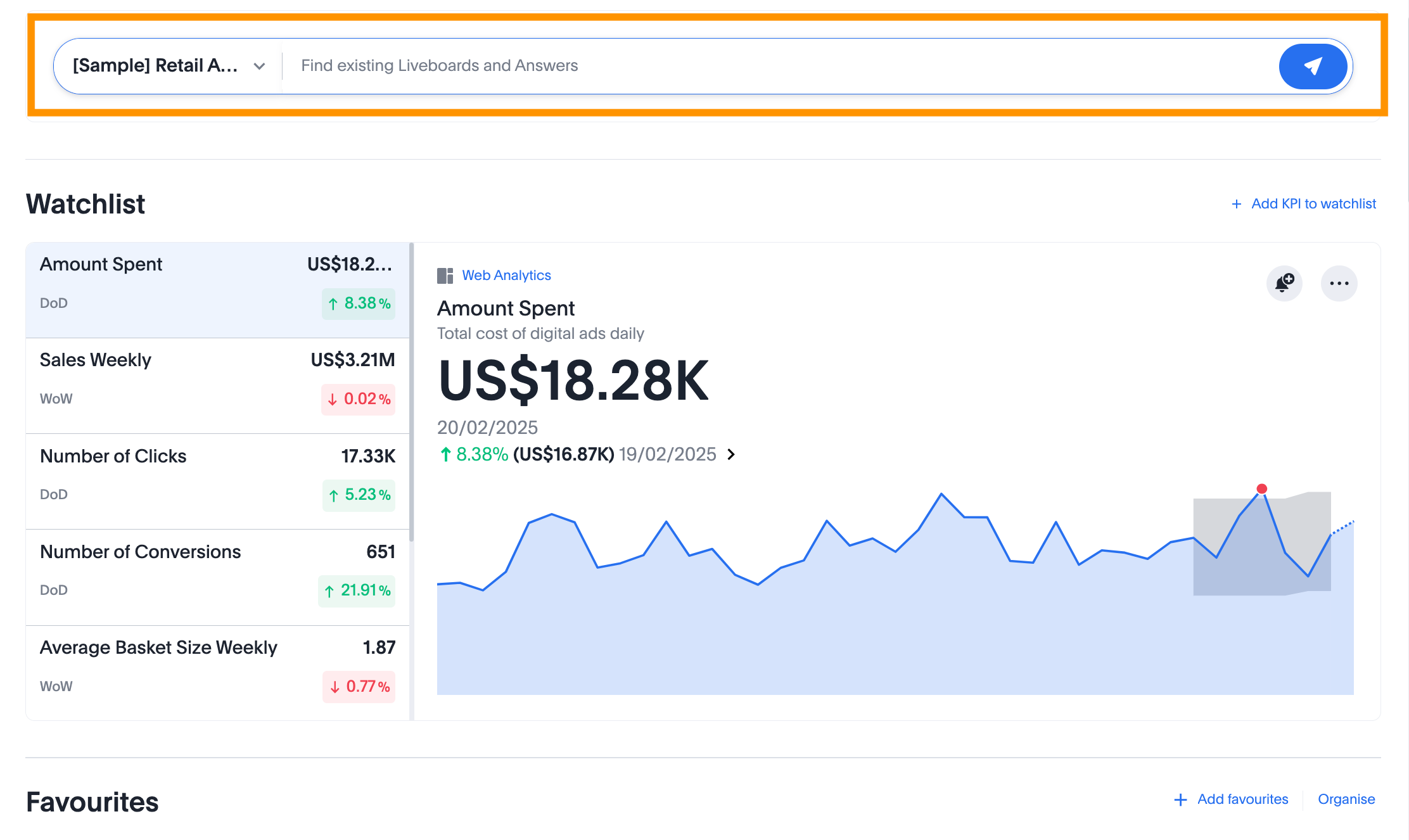
- AI Search page
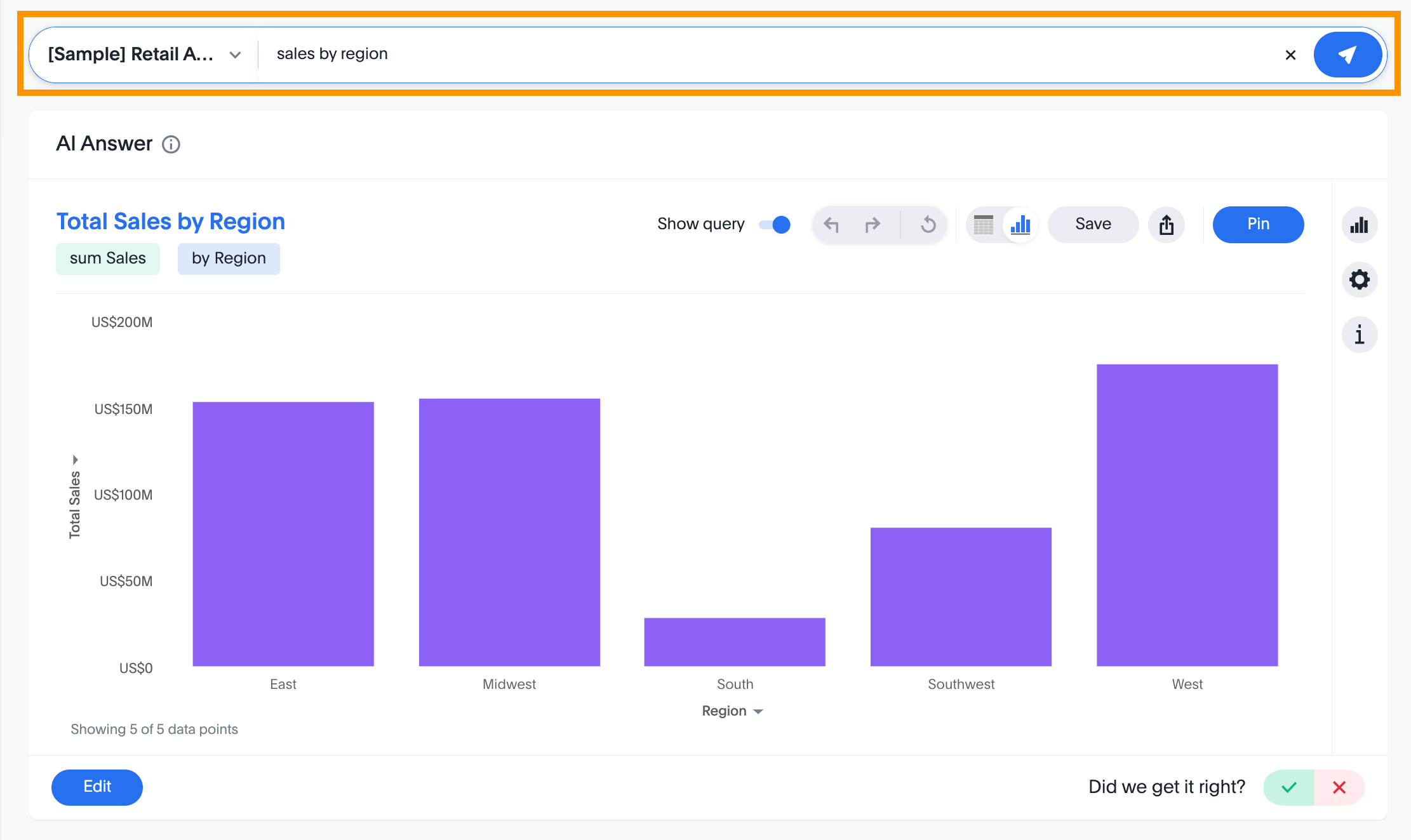
Home page classic experience
const embed = new AppEmbed("#embed", {
homePageSearchBarMode: "aiAnswer",
});- Home page search experience
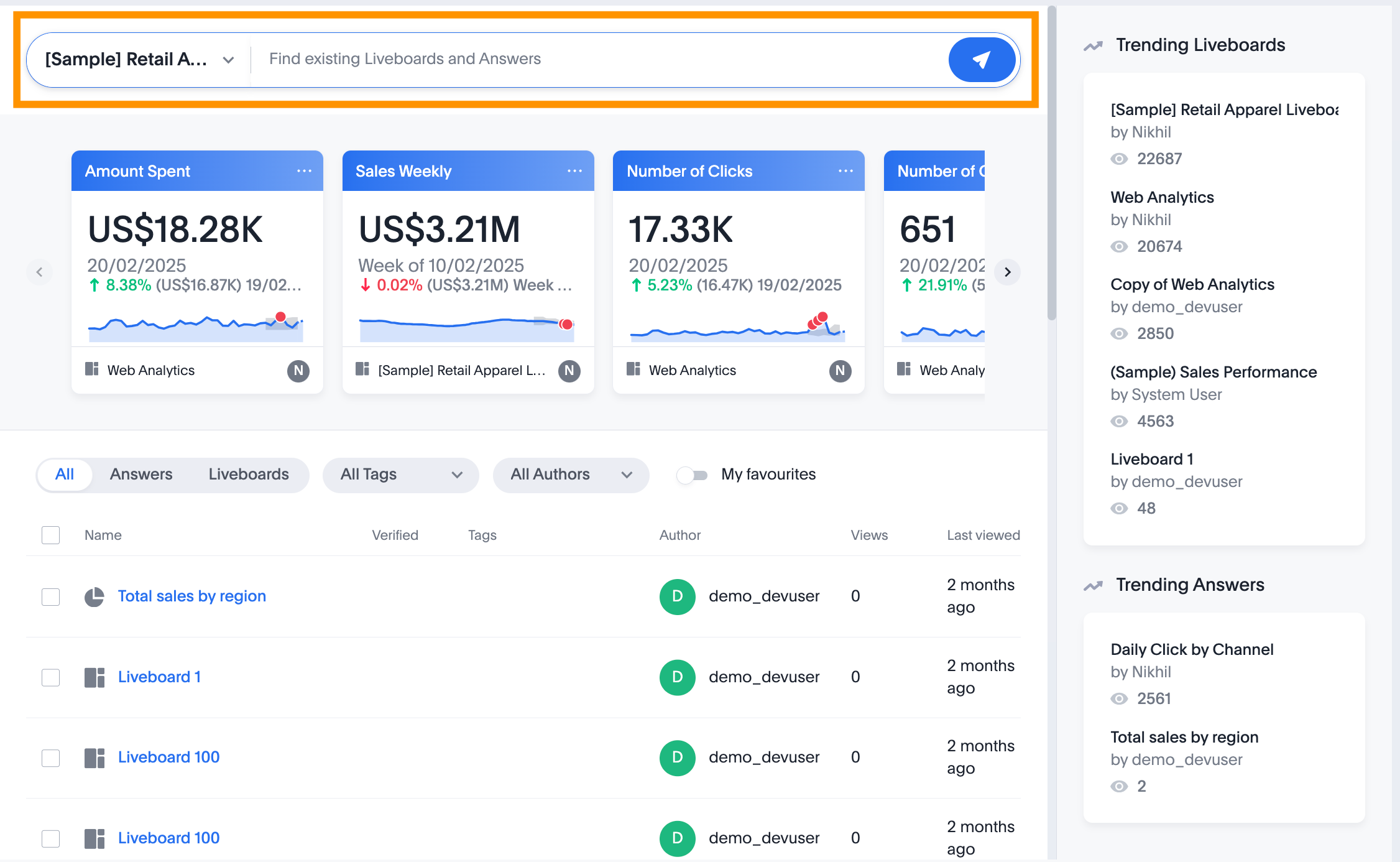
- AI Search page

Customize navigation controls🔗
The AppEmbed package in the Visual Embed SDK provides several parameters to hide or customize navigation controls.
The top navigation menu bar (classic experience), app selector  (New experience), and left navigation panel on the home page (New experience) are hidden by default in the embedded view. To show these elements in the embedded view, set
(New experience), and left navigation panel on the home page (New experience) are hidden by default in the embedded view. To show these elements in the embedded view, set showPrimaryNavbar to true. If the navigation panel is visible in the embedded view, you can use the following parameters in the AppEmbed component for additional customization:
-
hideOrgSwitcher
Hides the Orgs drop-down. Applicable to only Orgs-enabled clusters. -
hideApplicationSwitcher
Hides the app selector . The app selector is available only in the new navigation and Home page experience mode.
. The app selector is available only in the new navigation and Home page experience mode. -
disableProfileAndHelp-
To hide help and profile icons (Classic experience)
-
To hide help and profile icons, Help and Chat with Support menu options on the Home page (New Experience).
-
Help menu customization🔗
On ThoughtSpot instances running 10.8.0.cl and later, a unified help and support experience is available. The new information center experience provides access to ThoughtSpot documentation and support and allows administrators to add custom links.
If you have embedded the full ThoughtSpot application with the top navigation bar and Help (?) icon with the showPrimaryNavbar: true and disableProfileAndHelp: false settings in the Visual Embed SDK and if you want to try the new information center experience, use the enablePendoHelp attribute in the SDK.
By default, the enablePendoHelp attribute is set to true for customer environments using the legacy information center generated by Pendo. To enable the new experience, you need to set enablePendoHelp to false.
const embed = new AppEmbed("#embed", {
... // other options
showPrimaryNavbar: true,
disableProfileAndHelp: false,
enablePendoHelp: false,
});Customize the left navigation panel on Home page (New experience)🔗
If the new navigation and Home page experience is enabled and showPrimaryNavbar to true, the home page displays a navigation panel on the left side of the Insights page. The panel consists of menu items such as Answers, Liveboards, SpotIQ Analysis, Monitor Subscriptions, and so on.
To hide the left navigation panel in the embedded view, set hideHomepageLeftNav to true.
const embed = new AppEmbed("#embed", {
... // other attributes
modularHomeExperience: true,
showPrimaryNavbar: true,
hideApplicationSwitcher: true,
hideHomepageLeftNav: true,
disableProfileAndHelp: true,
});If you don’t want to hide the left navigation panel, but show only a select few menu items, use hiddenHomeLeftNavItems array.
const embed = new AppEmbed("#embed", {
modularHomeExperience: true,
showPrimaryNavbar: true,
hiddenHomeLeftNavItems: [HomeLeftNavItem.Home,HomeLeftNavItem.Liveboards],
});Customize Home page modules (New experience)🔗
If the new navigation and Home page experience is enabled on your ThoughtSpot instance, the Home page shows modules such as watchlist, favorites, a library of Answers and Liveboards, trending charts and more. To customize these modules and the Home page experience, use the hiddenHomepageModules array.
const embed = new AppEmbed("#embed", {
modularHomeExperience: true,
hiddenHomepageModules : [HomepageModule.Learning,HomepageModule.MyLibrary]
});To reorder Home page modules, use the reorderedHomepageModules array.
const embed = new AppEmbed("#embed", {
modularHomeExperience: true,
reorderedHomepageModules:[HomepageModule.Search,HomepageModule.Favorite,HomepageModule.Trending]
});Hide columns on list pages🔗
You can hide the following columns on the Liveboards and Answers listing pages using the hiddenListColumns array:
-
Author
-
Favorite
-
Last modified
-
Tags
-
Share
To hide one or several columns on the list pages, pass the relevant list page column enumerations in the hiddenListColumns array:
-
ListPageColumns.Author -
ListPageColumns.Favourite -
ListPageColumns.DateSort -
ListPageColumns.Tags -
ListPageColumns.Share
const embed = new AppEmbed("#embed", {
// hide Author, Share, and Tags columns on Answers and Liveboards list page
hiddenListColumns: [ListPageColumns.Author,ListPageColumns.Share,ListPageColumns.Tags]
});|
Note
|
The |
Detect changes in the currently loaded page🔗
Various actions the user takes within the embedded ThoughtSpot application may cause navigation within ThoughtSpot.
The embedding web application can listen for the EmbedEvent.RouteChange event by attaching an event listener to the AppEmbed object. The response has a currentPath property which is the path after the ThoughtSpot domain, for example:
pinboard/96a1cf0b-a159-4cc8-8af4-1a297c492ff9
To parse the currentPath into varying useful components, this tsAppState object code can be created in the global scope for use by any other web application code:
// Simple global object to handle details about what is visible in the AppEmbed component at a given moment
let tsAppState = {
currentPath: startPath,
currentDatasources: [], // Can be set later when detected from TML or other events
// return back what is being viewed at the moment, in the form that will translate to the pageId property if captialized, or path property if not
get pageType() {
if (this.currentPath.includes('/saved-answer/')){
return 'answer';
}
else if (this.currentPath.includes('/pinboard/')){
return 'liveboard';
}
/*
* Others are meant to match the exact pageId from SDK
*/
else if(this.currentPath.includes('/answer/')){
return 'Search';
}
else if(this.currentPath.includes('/answers')){
return 'Answers';
}
else if (this.currentPath.includes('/pinboards')){
return 'Liveboards';
}
else if(this.currentPath.includes('/insights')){
return 'SpotIQ';
}
else if(this.currentPath.includes('/monitor')){
return 'Monitor';
}
else if(this.currentPath.includes('/data')){
return 'Data';
}
else {
return 'Home';
}
},
// If viewing an Answer or Liveboard, returns the GUID of that object from the parsed URL
get objectId() {
let pathParts = this.currentPath.split('/');
// '/saved-answer/' is path for Answers (vs. /answer/)
if (this.currentPath.includes('/saved-answer/')){
answerGUID = pathParts[2];
return pathParts[2];
}
// '/pinboard/' is path for saved Liveboards
else if (this.currentPath.includes('/pinboard/')){
let pathParts = this.currentPath.split('/');
// May need adjustment for tabbed views to add in current Tab
liveboardGUID = pathParts[2];
return pathParts[2];
}
else{
return null;
}
}
}The following example shows the event listener code updating the global tsAppState object above whenever there is a change within the embedded ThoughtSpot app:
embed.on(EmbedEvent.RouteChange, (response) => {
// console.log("RouteChange fires");
// console.log(response);
// tsAppState object has currentPath property, which allows its other methods to parse out pageId, object type, GUIDs etc.
tsAppState.currentPath = response.data.currentPath;
console.log("TS App page is now: ", tsAppState.currentPath);
// Update elements within your web application based on the new state of ThoughtSpot (adjust menu selections, etc.)
})Navigate using a custom action🔗
To add a custom action for in-app navigation, follow these steps:
-
Define the navigation path
In this example, the view-report action on a Liveboard page calls the navigateTo method to open a specific saved Answer page when a user clicks the View report button in the embedded app.
appEmbed.on(EmbedEvent.CustomAction, async (payload: any) => {
if (payload.payload.id === 'view-report') {
appEmbed.navigateToPage(
'saved-answer/3da14030-11e4-42b2-8e56-5ee042a8de9e'
);
}
})If you want to navigate to a specific application page without initiating a reload, you can set the noReload attribute to true as shown here:
appEmbed.on(EmbedEvent.CustomAction, async (payload: any) => {
if (payload.payload.id === 'view-report') {
appEmbed.navigateToPage('saved-answer/3da14030-11e4-42b2-8e56-5ee042a8de9e', true);
}
})CSS customization and hiding page elements🔗
CSS customization allows overriding the default styles from the ThoughtSpot application, including the application pages.
If there is an element of a page that you dislike and cannot hide with any combination of other options in ThoughtSpot, you can often use CSS customization to target the element and apply either display: none;, visibility: hidden; or height: 0px; and make it functionally disappear to the end user.
Specifying a direct element using the direct CSS selectors vs. the ThoughtSpot provided variables. To discover the appropriate selector, use the Inspect functionality of your browser to bring up the Elements portion of the browser’s Developer Tools, then look at the Styles information.
An example of using direct selectors in a file is available in the complete.css.
.bk-data-scope .left-pane .header-lt {
display: none !important;
visibility: hidden !important;
}Direct selectors can also be declared using rules in the Visual Embed SDK code. This is useful for real-time testing, particularly in the Visual Embed SDK playground. Note the format for encoding CSS rules into the JavaScript object format used by for rules.